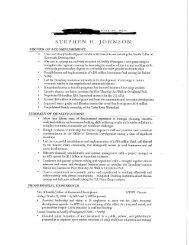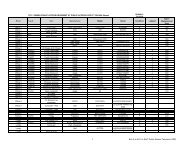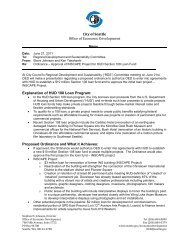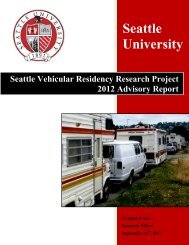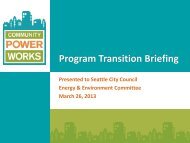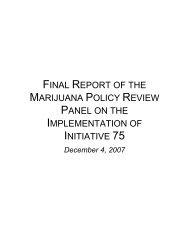2013 Water System Plan, Volume II - Seattle City Clerk's Office - City ...
2013 Water System Plan, Volume II - Seattle City Clerk's Office - City ...
2013 Water System Plan, Volume II - Seattle City Clerk's Office - City ...
Create successful ePaper yourself
Turn your PDF publications into a flip-book with our unique Google optimized e-Paper software.
actual experience with the 1987 Tolt Pipeline break repair.) This analysis also<br />
demonstrated that Roosevelt and Volunteer Reservoirs could be decommissioned, and<br />
affirmed that Lincoln, Myrtle, Beacon, and West <strong>Seattle</strong> Reservoirs could be downsized<br />
to what is now in place.<br />
2. Treatment Facility Outages<br />
The first set of scenarios examines the reliability of the system in the event of loss of<br />
treated water delivery from one of the two primary treatment facilities. These scenarios<br />
could be due to the loss of treatment capability at the treatment plant itself, or loss of<br />
transmission to or from the treatment plant. It should be noted that both the Tolt and<br />
Cedar <strong>Water</strong> Treatment Facilities have backup electrical power supplies, as well as dual<br />
treatment trains, which reduce the likelihood of full loss of treated water supply. The<br />
Tolt <strong>Water</strong> Treatment Facility has a maximum treatment capacity of 120 MGD, and the<br />
Cedar <strong>Water</strong> Treatment Facility has a maximum treatment capacity of 180 MGD.<br />
These scenarios were analyzed as part of the Tolt/Cedar Transfer Improvements Study<br />
conducted in 2006 and 2007. The study analyzed five emergency scenarios that represent<br />
complete outage of the Tolt or Cedar supply, both during peak week and the off-peak<br />
season, and complete Tolt outage during a shoulder (spring or fall) season. The different<br />
system-wide demand levels were as follows:<br />
• Off-peak demand (November through March) of 110 MGD<br />
• “Shoulder season” demand level (June and September) of 170 MGD<br />
• Peak day demand of 250 MGD, with reduction to indoor water use only demand of<br />
120 MGD under emergency mandatory water use restrictions within 12-24 hours.<br />
Tolt Outage. This scenario examines complete failure of the Tolt <strong>Water</strong> Treatment<br />
Facility during the summer or shoulder season, requiring s days to repair. The scenario<br />
assumes that the clearwell and Tolt transmission pipelines are in service. The results<br />
indicate that off-peak water demands can be met indefinitely without any supply from<br />
Tolt, and without storage drawdown. If the emergency were to occur during higher<br />
demands, public messaging would be implemented to bring demand down to indoor<br />
levels within 12-24 hours, during which time service would be maintained by drawing<br />
down transmission and distribution reservoirs while maintaining at least 20 psi in the<br />
distribution system.<br />
Cedar Outage. This scenario examines complete failure of Cedar <strong>Water</strong> Treatment<br />
Facility during summer, requiring 7 days to repair. It is assumed that the Clearwells<br />
would be available and Control Works would be functional. The operating strategy<br />
would be to reconfigure several transmission pipeline junctions (some remotely, while<br />
others manually in the field) so that available supply from the Tolt could be delivered far<br />
south into the area typically served by the Cedar. Additionally, the <strong>Seattle</strong> Wells would<br />
be activated without on-site treatment, if necessary, within 8 hours of the onset of the<br />
emergency. The analysis demonstrated that normal service can be maintained for up to 7<br />
days at indoor water use levels through a combination of supply from the Tolt and the<br />
<strong>Seattle</strong> Wells and from drawing down reservoirs while maintaining at least 20 psi in the<br />
-3-



